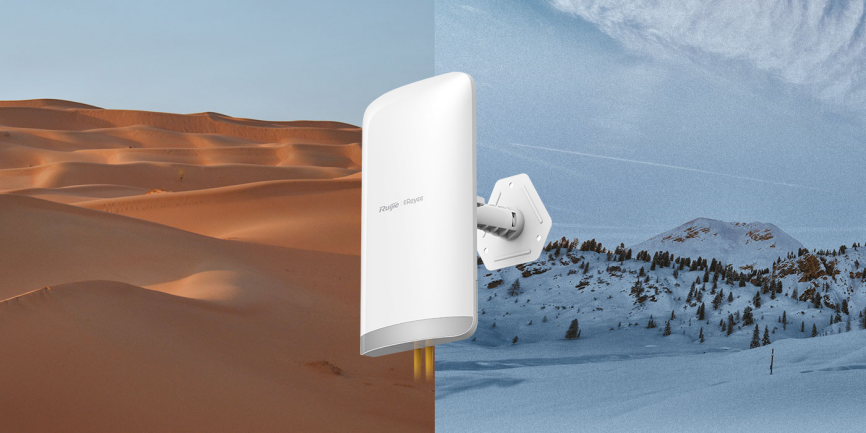Wireless Bridge Router combines the dual functions of a bridge and router, forwarding packets based on network protocol information. The application scenarios of Wireless Bridge Routers are very diverse, primarily serving the following two needs:
Expanding Network Coverage: In environments with large buildings, outdoor areas, or numerous obstacles that impede signal penetration, Wireless Bridge Router can effectively solve signal dead zone issues and significantly expand wireless network coverage.
Enabling Wireless Roaming: In a wireless bridge network, by configuring the same SSID and password, seamless roaming of wireless devices can be achieved. When users move between different bridge points, devices automatically switch to the bridge point with stronger signal, maintaining network connection stability.
Besides connecting computers, smart furniture, gaming consoles, media players, and office equipment, Wireless Bridge Router is widely used in outdoor scenarios to meet the network connectivity needs of modern urban facilities.

What Are the Applications of Wireless Bridge Routers in Outdoor Scenarios?
Commercial Buildings
In large commercial buildings, due to complex building structures and high indoor wiring costs, using wireless bridge routers for indoor and outdoor wireless information transmission not only saves wiring costs but also helps improve network security. Wireless Bridge Routers are typically deployed in external areas of commercial buildings or between floors where wiring is difficult, providing stable and efficient network connections.
Tourist Attractions
Tourist attractions usually have vast outdoor areas and complex geographical environments. Appropriate deployment of Wireless Bridge Router devices can provide better wireless network services for tourists and enhance their visiting experience. Especially in key locations such as scenic area entrances, parking lots, and rest areas, Wireless Bridge Routers can ensure stable network connections for tourists to enjoy convenient online services.
Remote Areas with Poor Communication
In remote areas with poor network coverage, deploying Wireless Bridge Routers can optimize wireless network coverage and improve the network environment. This not only enhances network services for local residents but also promotes information technology development in rural areas.
Surveillance and Security
Elevator Monitoring: Installing wireless bridge routers in elevators enables wireless transmission of elevator surveillance footage. This avoids the complexity and cost of wiring in elevator shafts while improving the stability and clarity of surveillance footage.
Construction Site Monitoring: In complex environments like construction sites, where construction periods are long and environments changeable, traditional wired surveillance methods are often difficult to implement. Wireless bridge routers provide flexible and efficient solutions for wireless transmission of construction site surveillance footage, ensuring construction safety and quality.
Community Surveillance: In community settings, due to wiring limitations, wireless bridge routers can be used for wireless transmission of surveillance footage, helping improve monitoring efficiency and reduce wiring costs.
Other Outdoor Scenarios
Large Campuses or Factory Areas: In these scenarios where buildings are widely distributed and distances are considerable, traditional wired networks often struggle to meet requirements. Deploying wireless bridge routers can achieve network interconnection within campuses or factory areas, improving network coverage and transmission efficiency.
Connecting Adjacent Urban Areas or Towns: For adjacent urban areas or towns, wireless bridge routers can establish network connections between different branch organizations. This avoids the complexity of road excavation or overhead line installation, reduces costs, and improves network connection stability and speed.
Temporary Venues: When conducting network transmission in temporary venues (such as promotional event sites, sports venues, etc.), wireless bridge routers provide a quick and convenient solution for building temporary network connections to meet on-site network requirements.
What Are the Challenges in Deploying Wireless Bridge Routers in Outdoor Scenarios?
Environmental Factors
The varying natural environment and weather conditions outdoors may affect the performance and stability of wireless bridge routers, requiring outdoor equipment to have high physical durability to withstand external impacts, vibrations, wind, rain, and other factors.
Transmission Distance and Loss
Long-distance transmission and obstacles may cause signal attenuation, affecting network performance. Low-loss transmission cables or additional relay devices may be needed to compensate for signal loss, and the choice of installation location is also crucial.
Anti-interference Capability
Various sources of electromagnetic interference exist in outdoor environments, such as high-voltage power lines and radio broadcasts, which may affect normal communication, causing data transmission errors or network instability. This requires equipment to have strong anti-interference capabilities.
Network Topology
Outdoor network topology requires more complex planning. Before deployment, it's necessary to determine appropriate network topology types, suitable communication frequencies, structural scalability and flexibility, and consider redundant design to improve long-term network stability and reliability.
If these issues are considered in advance when selecting equipment, most can be avoided early on to reduce subsequent maintenance pressure. Qualified manufacturers will first fully understand the climate, temperature, terrain, and other characteristics of the installation site when facing customer needs, then develop reliable equipment configuration solutions based on actual conditions. Professional staff from manufacturers will also actively perform equipment debugging and configuration. It is recommended that users prioritize leading industry manufacturers like Ruijie Reyee, who not only provide superior equipment quality but also have professional engineering teams offering reliable services throughout the process.

As network demands in different regions continue to upgrade, the application of Wireless Bridge Router in outdoor scenarios will become increasingly widespread. Beyond commercial buildings, tourist attractions, surveillance and security scenarios, there is still a large deployment demand in rural areas and more remote regions where network infrastructure is currently less developed. Manufacturers need to further optimize configuration solutions, improve network coverage and transmission efficiency, and optimize the internet environment for all people through more targeted deployment measures.
Featured Articles
- Networking Tools for Retail Stores: The Core Value of Cloud-Managed APs












